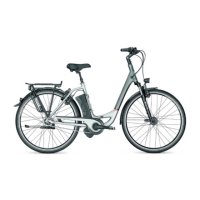III User Manual Pedelec with centre motor 17
5 Assistance by the electric motor
If your Pedelec is equipped with hub gears, you may
have to take more load o the pedals when changing
gears than you would normally do when riding your
conventional bike. This is due to the additional power
output of the electric motor. The hub gear system
contains a device that protects it against gear shiing
operations under excessive loads in order to preserve
the gear unit in the hub.
5.1 Operating principle of assistance
The motor provides support as soon as you switch the as-
sistance on and start pedalling.
The thrust delivered by the motor depends on three factors:
• Your own pedalling eort
The motor adapts to the force you apply. If you
pedal harder, e.g. uphill or when setting o, the
power sensor detects this and increases the thrust
accordingly. However, the thrust is limited by the
maximum motor output.
Variation in electric assistance
Propulsive power
Speed
increasing pedal
power and
assistance
reducing
assistance
assistance
switched o
Power-assist mode = 1 : 2
Pedal force
22km / h 25km / h
Propulsive power (pedal force +
electric assistance)
Electric assistance
1.0
2
Pedelec 28" • 8-speed • Shimano
• The assist level you have selected
With the "high assist level / HIGH" the power deliv-
ered by the motor is double your own eort (1:2).
With the "medium assist level / MID", the power
delivered by the motor matches your own eort
(1:1). With the "low assist level / LOW / ECO", the
power delivered by the motor is half your own ef-
fort (1 : 0.5).
• The speed at which you are currently travelling
When you set o on your Pedelec, the assistance
increases as you build up speed until your bike
reaches its maximum speed of roughly 22km / h.
The assistance then reduces automatically until
you reach a speed of roughly 25km / h when it
switches o. This applies for the largest gear only.
In all other gears, the motor switches o earlier,
depending on the gear ratio.

